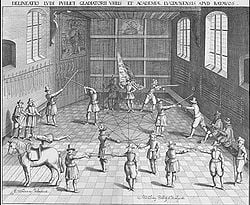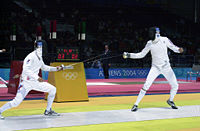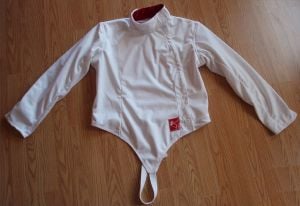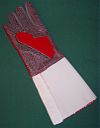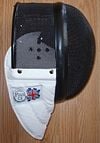Fencing
The sport of Fencing is a sport of armed combat that is one of the remaining original events that was in the 1908 Olympic Games. Its three main types of competition are the Epee, Foil, and Sabre which define the weapon used for defense and attack.
The sport traces its origin to ancient times as fencing was an ancient form of combat in warfare. Today the competitive element has been distilled from its violent origins to create a sport of agility, speed and endurance. The goal of fencing remains the same as the goal of warfare—to best the other fencer—but without the trappings of violence.
History of Fencing
The earliest evidence that has been found on the sport goes back to 1200 B.C.E., where a carving was found depicting a sport with protective weapons with tips, and masks.
The Greek and Roman civilizations practiced swordsmanship but the emphasis regressed through the Dark Ages, due the collapse of the Roman civilization during around 476 C.E., when the barbarian invaders brought their heavy weapons to the area.
In the beginning of the Renaissance during the fourteenth century, the introduction of fast, light weapons returned. With a few rare exceptions, the sword was still known as a heavy, clumsy weapon. It was used mostly as a weapon for dealing with armor-hewing blows, and had little point work involved.
The fifteenth century was the beginning of modern fencing as we know it today. Spain was known for having the first fencers in the sport, and also produced the first two manuals for the sport in 1471 and 1474 respectively. Italians starting using the rapier, and fencing greats such as Agripa, Grasi, and Vigiani emerged.
In the sixteenth century, the sport had a huge surge in popularity. The queen of France had many of the masters from Italy come to introduce the sport in 1567. Her son King Charles IX, recognized the French Fencing Academy, and started to award titles to these new men. These masters were the first to define and classify different terms to fencing attack methods.
The seventeenth century brought the introduction of the foil in France as a light weapon for the purpose of training. This brought new rules to the game that gave new ways to attack and defend, and also made the game safer. In 1780, the mask was introduced to the sport of fencing by La Boessiere, another safety precaution. This made the game much more popular–less fatal and much more strategic.
While the game was known in the old world for quite some time, it came to America in the 1860s because of immigrants from Italy and France. The first fencing school was introduced in America in 1874. The Olympics recognized the sport of fencing at the first modern Olympic games in 1896, and women's fencing was introduced in 1924.
In the early times of the twentieth century, the FIE or the International Fencing Federation was founded in France. The French, Italians and Hungarians dominated most fencing competitions for the first half of the century. Then a new generation focusing on speed and quickness was introduced by the Russians and Italians. The new focus on speed and the introduction of the electronic scoring machine gave the game an even more strategic element.
Introduction to Fencing
In the broadest possible sense, fencing is the art of armed combat involving cutting, stabbing, or bludgeoning weapons directly manipulated by hand, rather than shot or thrown. Example weapons include swords, knives, pikes, bayonets, batons, clubs, and similar. In contemporary common usage, 'fencing' tends to refer specifically to European schools of swordsmanship and to the modern Olympic sport that has evolved out of them.
Fencing is one of the four sports which has been featured at every modern Olympic Games. Currently, three types of weapon are used in Olympic fencing:
- Foil—a light thrusting weapon; the valid target is restricted to the torso; double hits are not allowed, (see priority rules below).
- Épée—a heavier thrusting weapon; the valid target area covers the entire body; double hits are allowed.
- Sabre—a light cutting and thrusting weapon; the valid target area includes almost everything above the waist (excluding the back of the head and the palms of the hands); double hits are not allowed, (see priority rules below).
Foil
The foil is a light and flexible weapon, originally developed in the mid 17th century as a training weapon for the small sword (a light one-handed sword designed almost exclusively for thrusting).
The target area is restricted to the torso. Hits can be scored only by hitting the valid target surface with the point of the weapon in such a manner as would have caused a puncture wound, had the weapon been sharp. A touch on an off-target area stops the bout but does not score a point. There are right of way or priority rules, whose basic idea is that the first person to create a viable threat or the last person to defend successfully receives a 'right' to hit. If two hits arrive more or less simultaneously, only the fencer who had the 'right of way' receives a point. If priority cannot be assigned unambiguously, no points are awarded. The original idea behind the foil rules was to encourage the fencers to defend and attack vital areas, and to fight in a methodical way with initiative passing back and forth between the combatants and thus minimizing the risk of a double death.
In modern competitive fencing 'electric' weapons are used. These have a push-button on the point of the blade, which allows hits to be registered by the electronic scoring apparatus. In order to register, the button must be depressed with a force of at least 4.90 newtons (500 grams-force) for at least 15 milliseconds. Fencers wear conductive (lamé) jackets covering their target area, which allow the scoring apparatus to differentiate between on- and off-target hits.
Épée
Épée, as the sporting weapon we know today, was invented in the second half of the 19th century by a group of French students, who felt that the conventions of foil are too restrictive, and the weapon itself too light; they wanted an experience closer to that of an actual duel. At the point of its conception, the épée was, essentially, an exact copy of a smallsword but without the needle-sharp point. Instead, the blade terminated in a point d'arrêt, a three-pronged contraption, which would snag on the clothing without penetrating the flesh.
Like the foil, the épée is a thrusting weapon: to score a valid hit, the fencer must fix the point of his weapon on his opponent's target. However, the target area covers the entire body, and, there are no rules regarding who can hit when (unlike in foil and sabre, where we have priority rules). In the event of both fencers making a touch within 40 milliseconds of each other, both are awarded a point (a double hit), except in modern pentathlon one-hit épée, where neither fencer receives a point. Otherwise, the first to hit always receives the point, regardless of what happened earlier in the phrase.
The 'electric' épée, used in modern competitive fencing, terminates in a push-button, similar to the one on the 'electric' foil. In order for the scoring apparatus to register a hit, it must arrive with a force of at least 7.35 newtons (750 grams-force) (a higher threshold than the foil's 4.9 newtons), and the push-button must remain fully depressed for 1 millisecond. All hits register as valid, unless they land on a grounded metal surface, such as a part of the opponent's weapon, in which case they do not register at all. At large events, grounded conductive pistes are often used in order to prevent the registration of hits against the floor. At smaller events and in club fencing, it is generally the responsibility of the referee to watch out for floor hits. These often happen by accident, when an épéeist tries to hit the opponent's foot and misses. In such cases, they are simply ignored. However, deliberate hits against the floor are treated as "dishonest fencing," and penalized accordingly.
Sabre
Sabre is the 'cutting' weapon: points may be scored with edges and surfaces of the blade, as well as the point. Although the current design with a light and flexible blade (marginally stiffer than a foil blade) appeared around the turn of the nineteenth century and twentieth century, similar sporting weapons with more substantial blades had been used throughout the Victorian era.
There is some debate as to whether the modern fencing sabre is descended from the cavalry sabres of Turkic origin (which became popular in Central and Western Europe around the time of Napoleonic Wars) or one of Europe's indigenous edged dueling weapons, such as the cutting rapier. In practice, it is likely to be a hybrid of the two. Most of the conventions and vocabulary of modern sabre fencing were developed by late nineteenth century and early twentieth century masters from Italy and Hungary, perhaps most notable among them being Italo Santelli (1866–1945).
Sabre fencing also grew based on the work of Michael Starzewski who wrote on the eleven different attack positions used in Sabre. The 1830 work was one of the first written on sabre fencing helped make this type of fencing grow significantly.
The sabre target covers everything above the waist, except the hands and the back of the head. Today, any contact between any part of the blade and any part of the target counts as a valid touch. This was not always the case, and earlier conventions stipulated that a valid touch must be made with either the point or one of the cutting edges, and must arrive with sufficient force to have caused a palpable wound, had the weapon been sharp. These requirements had to be abandoned, because of technical difficulties, shortly after electronic scoring was introduced into sabre fencing in late 1980s.
Like foil, sabre is subject to right of way rules, but there are some differences in the precise definition of what constitutes a correctly executed attack and parry. These differences, together with a much greater scoring surface (the whole of the blade, rather than the point alone), make sabre parries more difficult to execute effectively. As a result, sabre tactics rely much more heavily on footwork with blade contact being kept to a minimum.
Etymology: The word 'fence' was originally a shortening of the Middle English 'defens'. The first known use in reference to swordsmanship is in William Shakespeare's Merry Wives of Windsor: 'Alas sir, I cannot fence.' [1]
Forms of fencing
Contemporary fencing is divided in three broad categories:
- Competitive fencing
- Fencing as a Western martial art
- Other forms of fencing
Competitive fencing
There are numerous inter-related forms of competitive fencing in practice, all of which approach the activity as a sport, with varying degrees of connectedness to its historic past.
Olympic fencing (or simply "fencing") refers to the fencing seen in most competitions, including the Olympic Games. Competitions are conducted according to rules laid down by the Fédération Internationale d'Escrime (FIE), the international governing body. These rules evolved from a set of conventions developed in Europe between mid 17th and early twentieth century with the specific purpose of regulating competitive activity. The three weapons used in Olympic fencing are foil, épée, and sabre. In competition, the validity of touches is determined by the electronic scoring apparatus, so as to minimize human error and bias in refereeing. Olympic competitions consists of individual and team metal winners.
Wheelchair fencing, an original Paralympic sport, was developed in post-World War II England. Minor modifications to the FIE rules allow disabled fencers to fence all three weapons. The most apparent change is that each fencer sits in a wheelchair fastened to a frame. Footwork is replaced by torso or arm movement, depending on the fencer's disability. The proximity of the two fencers tends to increase the pace of bouts, which require considerable skill. The weapons are identical to those used in Olympic fencing.
Other variants include one-hit épée (one of the five events which constitute modern pentathlon) and the various types of competitive fencing, whose rules are similar but not identical to the FIE rules. One example of this is the American Fencing League (distinct from the United States Fencing Association): the format of competitions is different, there is no electronic scoring, and the priority rules are interpreted in a different way. In a number of countries, the accepted practice at school and university level deviates slightly from the FIE format.
Fencing as a Western martial art
Some practitioners of fencing approach it as a Western martial art, with the goal being to train for a theoretical duel. The element of sport is absent (or nearly so) from these forms of fencing, but they all share a common origin with each other and with competitive fencing.
Classical fencing is differentiated from competitive fencing as being theoretically closer to swordplay as a martial art. Those who call themselves classical fencers may advocate the use of what they see as more authentic practices, including little or no emphasis on sport competition. There is strong interest within the classical fencing community in reviving the European fencing practices of the nineteenth and early twentieth century, when fencers were expected to be able to fight a duel using their training. Weapons used are the standard (non-electric) foil, standard epee (often equipped with pointes d'arret), and the blunted dueling sabre. AFL fencing is often referred to as classical fencing, but this is a misnomer.
Historical fencing is a type of historical martial arts reconstruction based on surviving texts and traditions. Predictably, historical fencers study an extremely wide array of weapons from different regions and periods. They may work with bucklers, daggers, polearms, bludgeoning weapons, etc. One main preoccupation of historical fencers is with weapons of realistic weight, which demand a different way of manipulating them from what is the norm in modern Fencing. For example, light weapons can be manipulated through the use of the fingers (more flexibility), but more realistically-weighted weapons must be controlled more through the wrist and elbow. This difference is great and can lead to drastic changes even in the carriage of the body and footwork in combat. There is considerable overlap between classical and historical fencing, especially with regard to 19th-century fencing practices.
Other forms of fencing
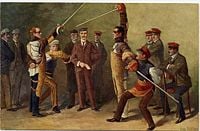
Finally, there are several other forms of fencing which have little in common besides history with either of the other two classifications.
Academic fencing, or mensur, is a German student tradition that is still practiced in Germany, Switzerland and Austria as well as in Flanders and Latvia. The combat, which uses a cutting weapon known as the schläger, uses sharpened blades and takes place between members of student fraternities—"Studentenverbindungen"—in accordance with a strictly delineated set of conventions. It uses special protective gear that leaves most of the head and face, excluding the eyes, unprotected. The ultimate goal is to develop personal character, therefore there is no winner or loser and flinching is not allowed. Acquiring a proper cut on the face with the sharp blade is one goal and a visible sign of manly courage.
Stage fencing seeks to achieve maximum theatrical impact in representing a wide range of styles, including both modern and historical forms of fencing. Theatrical fight scenes are choreographed and fencing actions are exaggerated for dramatic effect and visual clarity.
Recreational roleplaying often incorporates fencing in the context of historical or fantasy themes in the Society for Creative Anachronism or live-action roleplaying games. Technique and scoring systems vary widely from one group to the next, as do the weapons. Depending on local conventions, participants may use modern sport fencing weapons, period weapons, or weapons invented specifically for the purpose, such as boffers.
Modern weapons
Three weapons survive in modern competitive fencing: foil, épée, and sabre. The spadroon and the heavy cavalry-style sabre, both of which saw widespread competitive use in the nineteenth century, fell into disfavor in the early twentieth century with the rising popularity of the lighter and faster weapon used today. The singlestick was featured in the 1904 Olympic Games, but it was already declining in popularity at that time. Bayonet fencing experienced a somewhat slower decline, with competitions organized by some armed forces as late as the 1940s and 1950s.
While the weapons fencers use differ in shape and purpose, their basic construction remains similar across the disciplines. Every weapon has a blade and a hilt. The tip of the blade is generally referred to as the point. The hilt consists of a guard and a grip. The guard (also known as the coquille, or the bellguard) is a metal shell designed to protect the fingers. The grip is the weapon's actual handle. There are a number of commonly used variants. The more traditional kind are approximately straight and terminate with a pommel (a heavy nut intended to act as a counterweight for the blade). In the case of foil and épée, these have been surpassed in popularity by a variety of ergonomic designs, often collectively refereed to as pistol grip (the way they are held resembles how one holds a pistol).
Protective clothing
The clothing which is worn in modern fencing is made of tough cotton or nylon. Kevlar was added to top level uniform pieces (jacket, breeches, underarm protector, lamé, and the bib of the mask) following the Smirnov incident at the 1982 World Championships in Rome, when Smirnov died from a fencing accident. However, Kevlar breaks down in chlorine and UV light, so the act of washing one's uniform and/or hanging it up in the sun to dry actually damaged the kevlar's ability to do the job.
For the uniform to be considered legal for competition, it has to pass a large amount of tests and rules. Below is the standard uniform that is worn and includes the following items of clothing:
- Form-fitting jacket covering groin and with strap (croissard) which goes between the legs, a small gorget of folded fabric is also sewn in around the collar to prevent a blade from slipping upwards towards the neck.
- Under-arm protector (plastron) which goes underneath the jacket and provides double protection on the sword arm side and upper arm. It is required to not have a seam in the armpit, which would line up with the jacket seam and provide a weak spot.
- One glove for the sword arm with a gauntlet that prevents blades from going up the sleeve and causing injury, as well as protecting the hand and providing a good grip
- Breeches or knickers which are a pair of short trousers. The legs are supposed to hold just below the knee.
- Knee-length or Thigh high socks which should cover knee and thighs.
- Shoes with flat soles and reinforcement on the inside of the back foot and heel of front foot, to prevent wear from lunging.
- Mask, including a bib which protects the neck. For competition, the bib must be sewn into the mask frame to eliminate a hole that might admit a blade. Thus, masks with snap-in bibs are not legal for competition. The mask can usually support 12 kilograms of force, however FIE regulation masks can stand much more, at least 27 kg.
- Plastic chest protector, mandatory for female fencers. An alternative to a full chest protector are breast protectors (known informally as "salad bowls"), plastic bowl-shaped items which are inserted into special breast pockets in the plastron. While male versions of the chest protector are also available, they were, until recently, primarily worn by instructors, who are hit far more often during training than their students. Since the change of the depression timing (see above), these are increasingly popular in foil, as the hard surface increases the likelihood of point bounce and thus a failure for a hit to register. Plastrons are still mandatory, though.
- Fencing Masters will often wear a heavier protective jacket, usually reinforced by plastic foam to cushion the numerous hits an instructor has to endure. Sometimes in practice, masters wear a protective sleeve or a leg leather for protection of their fencing arm or leg.
Traditionally, the uniform is white in color. This is primarily to assist the judges in seeing touches scored (black being the traditional color for masters), but rules against non-white uniforms may also have been intended to combat sponsorship and the commercialization of the sport. However, recently the FIE rules have been relaxed to allow colored uniforms. The color white might also be traced back to times before electronic scoring equipment, when the blades were sometimes covered in soot, ink, or colored chalk to make a mark on the opponent's clothing.
Scoring
Prior to the introduction of electronic scoring equipment, a director (formerly called the president of jury) was assisted by four judges. Two judges were positioned behind each fencer, one on each side of the strip. The judges watched the fencer opposite to see if he was hit. This system is sometimes called "dry" fencing (USA) or "steam" (United Kingdom, Australia) fencing.
Electronic scoring is used in all major national and international, and most local, competitions. At Olympic level, it was first introduced to épée in 1936, to foil in 1956, and to sabre in 1988. The central unit of the scoring system is commonly known as "the box." In the simplest version both fencers' weapons are connected to the box via long retractable cables. The box normally carries a set of lights to signal when a touch has been made. (Larger peripheral lights are also often used.) In foil and sabre, because of the need to distinguish on-target hits from off-target ones, special conductive clothing and wires must be worn. This includes a lamé, (a jacket of conducting cloth) for both weapons, a body cord to connect the weapon to the system, a reel of retractable cable that connects to the scoring box and in the case of sabre, a conducting mask and cuff (manchette) as the head and arms are valid target areas.
See also
Notes
- ↑ Douglas Harper, (2001), Online Etymology Dictionary Retrieved December 24, 2007.
ReferencesISBN links support NWE through referral fees
- Barbaseti, L. The art of the foil, with A short history of fencing. E.P. Dutton & Co., 1932. OCLC 860556
- Cross, T. Introduction to Fencing. Stipes Publishing, 1996. ISBN 0875636675
- Evangelista, Nick. The Art and Science of Fencing. Chicago: Masters Press, 1996. ISBN 1570280754
- Evangelista, Nick. The Inner Game of Fencing: Excellence in Form, Technique, Strategy, and Spirit. Chicago: Masters Press, 2000. ISBN 1570282307
- United States Fencing Association. September, 2005. United States Fencing Association Rules for Competition. Official document. USFencing. Retrieved December 1, 2005.
External links
All links retrieved April 5, 2017.
Olympic fencing
- Fédération Internationale d'Escrime The body responsible for all international Olympic fencing
- Australian Fencing Federation
- British Fencing Association
- Canadian Fencing Federation
- Dutch Fencing Association
- French Fencing Federation
- Italian Fencing Federation
- United States Fencing Association
Governing bodies for other forms
- Italian Historical Fencing Federation
- Sala d'Arme Achille Marozzo Ancient Fencing Art Italian Institute
Other sites
- Fencing FAQ from rec.sport.fencing
- FencingPhotos Official photographer of the Fédération International d'Escrime
- AskFRED: Fencing Results and Events Database
- Fencing.Net A large online fencing community
Credits
New World Encyclopedia writers and editors rewrote and completed the Wikipedia article in accordance with New World Encyclopedia standards. This article abides by terms of the Creative Commons CC-by-sa 3.0 License (CC-by-sa), which may be used and disseminated with proper attribution. Credit is due under the terms of this license that can reference both the New World Encyclopedia contributors and the selfless volunteer contributors of the Wikimedia Foundation. To cite this article click here for a list of acceptable citing formats.The history of earlier contributions by wikipedians is accessible to researchers here:
The history of this article since it was imported to New World Encyclopedia:
Note: Some restrictions may apply to use of individual images which are separately licensed.
